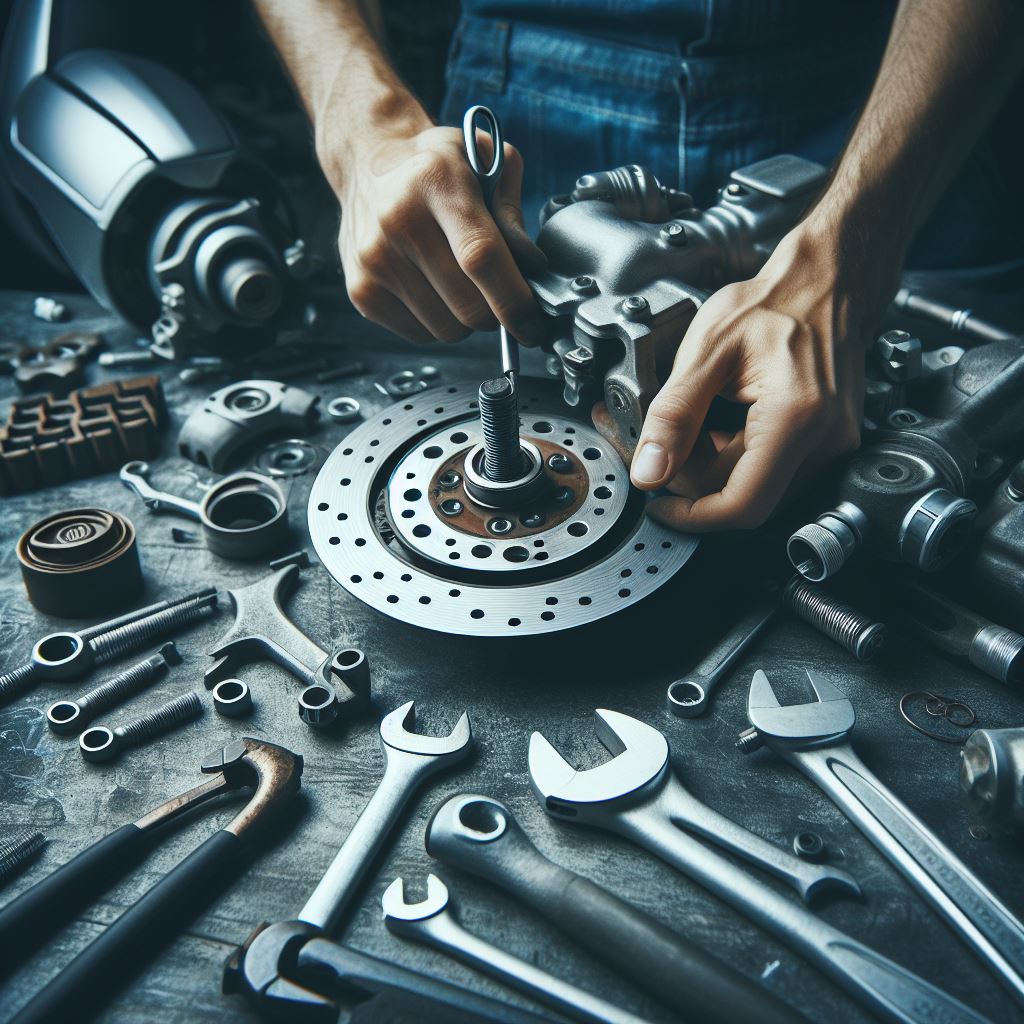How Often Should Scooter Brakes Be Bled: A Scooter Guide
Are you an avid scooter rider who loves the thrill of cruising around town on two wheels? It’s important to ensure your scooter is in top-notch condition, especially regarding the brakes. Have you ever wondered how often scooter brakes should be bled?
Brake maintenance is crucial for both the safety and performance of your scooter. If your brakes haven’t been bled in a while, it may be time to give them some much-needed attention. In this article, we will explore the frequency of scooter brakes being bled and provide helpful tips to keep your scooter running smoothly. So, to ensure that your scooter’s brakes are working optimally, keep reading to find out how often you should be bleeding them.
Table of Contents
How often should scooter brakes be bled?

The frequency of bleeding scooter brakes depends on several factors, including the type of brake system and the riding conditions. Generally, a good rule of thumb is to bleed your brakes every 6 months or when you notice a decrease in braking performance. If you ride your scooter frequently in wet or muddy conditions, it’s best to bleed your brakes more often. Other signs that it may be time to bleed your brakes include a spongy feeling when braking or an increase in lever travel before the brakes engage.
How long do brake pads last on a scooter?
The longevity of your electric scooter brakes hinges on various factors, such as your usage frequency, riding style, and brake brand. Generally, your brakes should last approximately 3-400 miles (480-640 km). Keep in mind that your front brakes may wear out first if you use them equally with the rear brakes.
Learn About: Do Scooter Brakes Require Specific Maintenance?
What is the process for bleeding scooter brakes?

Bleeding scooter brakes is an important maintenance task that involves removing air bubbles from the brake system to ensure proper brake performance. Here’s a general guide on how to bleed hydraulic disc brakes on a scooter:
Note: This guide assumes you have a basic understanding of scooter mechanics. If you're unsure about any step, it's recommended to consult your scooter's manual or seek assistance from a professional mechanic.Materials Needed:
- Brake fluid (check your scooter’s manual for the appropriate type)
- Clear plastic tubing (small diameter)
- Brake fluid catch bottle
- Wrenches or Allen keys (as needed)
- Bleed kit (optional, may include a syringe or vacuum pump)
Steps:
- Prepare Your Workspace: Find a well-ventilated and clean area to work on your scooter. Ensure you have all the necessary tools and materials ready.
- Check Brake Fluid Level: Ensure the brake fluid reservoir is filled to the recommended level. Top off the reservoir with the appropriate brake fluid if needed.
- Wheel Removal (if necessary): Depending on your scooter’s design, you might need to remove the wheel to access the brake caliper and bleed screw. Follow your scooter’s manual for instructions on wheel removal.
- Locate the Bleed Screw: Locate the bleed screw on the brake caliper. It’s typically located on the highest point of the caliper. The bleed screw may have a rubber cap covering it.
- Attach Tubing and Catch Bottle: Attach a piece of clear plastic tubing to the bleed screw. Place the other end of the tubing into a catch bottle to collect the old brake fluid.
- Prevent Contamination: Brake fluid is corrosive and can damage painted surfaces. Place a rag or cloth around the area to catch any spills and prevent contamination.
- Open Bleed Screw: With the scooter on its center stand or securely supported, gently open the bleed screw using a wrench or appropriate tool. You’ll start to see brake fluid and air bubbles flow through the tubing into the catch bottle.
- Pump the Brake Lever: Have a helper gently squeeze and hold the brake lever. While the lever is held down, open the bleed screw slightly to allow brake fluid and air to escape. Close the bleed screw before your helper releases the brake lever. Repeat this process several times until you see clear brake fluid without air bubbles.
- Check Reservoir Level: Regularly check the brake fluid reservoir level while bleeding to ensure it doesn’t go too low. Add more brake fluid to the reservoir as needed.
- Repeat for All Brake Calipers: If your scooter has multiple brake calipers, repeat the bleeding process for each caliper, starting with the one farthest from the brake reservoir.
- Close Bleed Screw: Once you’ve successfully removed air bubbles from the system, close the bleed screw securely.
- Test Brakes: Gently squeeze the brake lever and ensure it feels firm and responsive. Test the brakes in a safe area at low speeds to ensure proper operation.
- Dispose of Brake Fluid Properly: Brake fluid is hazardous waste. Dispose of the old brake fluid according to your local regulations.
Remember that this is a general guide. The exact procedure might vary based on your scooter’s make and model. If you’re not comfortable with the process, it’s recommended to have a professional mechanic perform the brake bleeding for you. Properly maintained brakes are crucial for your safety while riding.
Why should I bleed my brakes?

Bleeding your brakes can be a great way to save time and money on bike maintenance. Not only will you no longer have to wait weeks for a bike shop appointment to bleed your brakes, but you’ll also be able to save yourself up to £20 each time.
Taking matters into your own hands when it comes to brake bleeding is an achievable task, and the most important thing you can do before you start is to ensure that you are working with the right equipment and tools. Having the right knowledge about how your brakes work could make all the difference in ensuring that your brakes are bled correctly and safely.
Another benefit of bleeding your brakes is that it can be a great opportunity to learn new skills. If you’re relatively new to bike maintenance or feel unconfident about getting involved in more complex repairs, practicing brake fluid changing is a great way to build confidence. Of course, always look up information before attempting any repair, as not following the correct steps or using incorrect parts could lead to more costly damages.
Frequently Asked Questions (FAQs)
1: How often should scooter brakes be bled?
It is recommended to bleed scooter brakes at least once a year or every 12,000 miles, whichever comes first. Regular maintenance of the brakes is crucial to ensure optimal performance and safety.
2: Why is bleeding scooter brakes necessary?
Bleeding scooter brakes are necessary to remove any air bubbles or contaminants that may have entered the brake system. This process ensures that the brakes function properly and provide reliable stopping power.
3: Can I bleed the scooter brakes myself?
While it is possible to bleed scooter brakes yourself, it is recommended to have the task performed by a professional mechanic. They have the tools and expertise to bleed the brakes and remove all air bubbles properly.
4: How do I know if my scooter brakes need bleeding?
Some signs that indicate scooter brakes may need bleeding include sponginess in the brake lever or pedal, reduced braking performance, or a longer brake lever travel. If you experience any of these symptoms, having the brakes inspected and potentially bled is advisable.
5: What happens if scooter brakes are not bled?
If scooter brakes are not bled regularly, air bubbles and contaminants can accumulate in the brake system, decreasing braking performance, brake fade, or even failure. Regularly bleeding the brakes ensures optimal safety and performance.
Conclusion
Scooter brakes should be bled at least once a year or every 12,000 miles, whichever comes first. This process is necessary to ensure the optimal performance and safety of your brakes. Bleeding your brakes yourself can save time and money, but it is recommended to have a professional mechanic perform the task for you. If you experience any signs of reduced braking performance, such as sponginess in the brake lever or pedal, it is important to have the brakes inspected and potentially bled.
